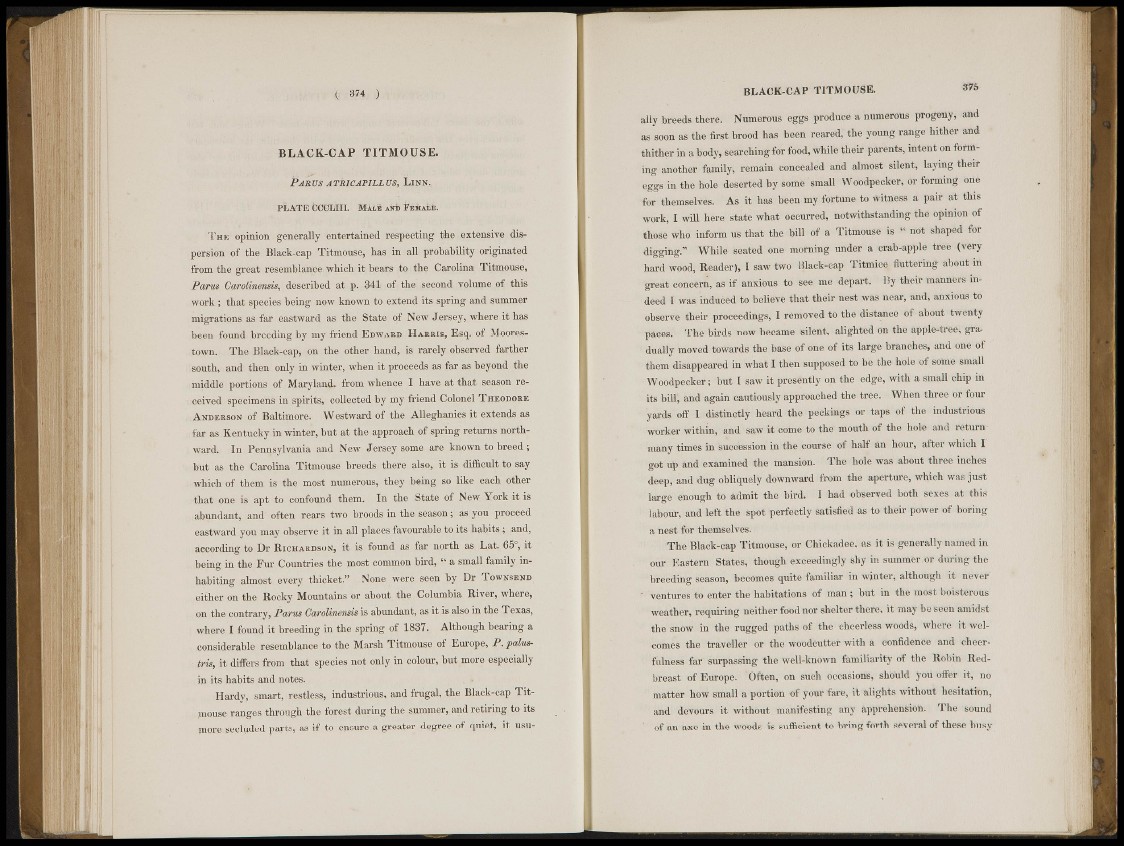
H 374 )
BLACK-CAP T I TMOUS E .
PAltUS ATR1CAPILLUS, LlNN.
PLiWfi tlCBMII. Male iirb fetiubfc.
The opinion generally entertained respecting the extensive dispersion
of tie: Black-cajp; Titmouse, has in all probability' originated
from the great resemblance which it bears to the Carolina Titmouse,
Pants Carolinensis, described at p. 311 of the; .second volume of this
work ; that species being no» known to extend^spring and summer
migrations as far eastward as: the State of New Jersey, where: it has
been found breeding by my friend Kdvvari> Habris, Esq. of Moorestown.
The Black-cap, A the bike» hand, is rarely observed farther
'south, and then only in winter, whim it proceeds a» far as beyond the
middle portions of Maryland, from wlk6|ie® ,1; ¡have at that season re-
. ««jived specimens in, spirits, collectedly my friend Colonel Theodore
Andkrsox of Baltimore. Westward of the A.l-leghaiiies it extends as
far as Kattucky in winter, but at the approach of spring, returns northward,
In Pennsylvania and Kjto Jersey some are known to breed;
but as the Carolina Titmouse breeds there also,- it is difficult to say
. which of them is the most numerous, they being so like each other
that-.-jyiic is apt to confound them. In the .State o f g w York it is
abundant, and often rears two broods in the Season; as you proceed
eastward you may observe it, in all plan's favourable to its habit,»; and,
according to Dr Richardson, i% is; found as far north as Lat. 05", it
being in the Fur Countries the most .common bird, « a Small family inhabiting
almost, every thicket." None were seen by l)r Townsend
s i l l i e r on the Rocky Mountains or about the Columbia River, where,
on the contrary, Parm Caroline,mis is abundant, as it is also in the Texas,
where I found it breeding in the spring of 1837. Although bearing a
considerable resemblance to the Marsh Titmouse of Europe, P. palustris,
it differs from that species not ogfy in colour, but more especially
Hardy, smart, restless, industrious, and frugal, the Black-cap TitjnojiSe
ranges throughfhe forest during the snimmer, and retiring to its
more secluded parts, as if to ensure a greater degree, of quiet, it usu-
B LACK-CAP T I TMOUS E . 375
ally breeds there. Numerous eggs produce a numerous psrogwiy, and
a* soon as: the first brood has been rear«!,' the young range hither and
thither in a body, searching for food, While their parents, intent on forming
another family, remain concealed and almost silent, laying their
eggs in the hole deserted by some small Woodpecker, or forming One
for themselves. As it has been my fortune to witness a pair at this
work, I will here: state what occurred, notwithstanding the opinion of
toe Who inform us that the bill of a Titmouse is " not shaped for
digging." While seated one morning under a crab-apple tree (very
hard wood, Reader), I saw two Black-cap Titmice fluttering about in
great concern, as if anxious to see me depart, By their maimers indeed
I was induced to believe that their nest was near, and, anxious to
observe their proceedings, I removed to the distance of about twenty
pases. The birds now became Silent, alighted on the apple-tree, gra,
dually moved towards the base of one of its large branches, and one of
them disappeared in vint I then supposed to be the hole of some small
Woodpecker; but I saw it presently on the edge, with a small chip in
its bill; and again cautiously approached the, tree. W.hen three or four
yards off 1 distinctly-' hearâl the peekings or taps of the industrious
worker Within, and saw it come to the mouth of the Ttote and return
many times in%aceWsion in the course of half An hour, after which I'
got up and examined the mansion. The hole was about three inches
deep, and dug obliquely downward from the aperture, which was just
laïge enough to admit thé bird, I had observed both sexes at this
labour, and left the spot perfectly satisfied as to their power of boring
a nest for themselves.-i*
The Black-cap Titmouse, or Chickadee, as it is generally named in
our Eastern States, though exceedingly shy in summer .or during the
breeding season, becomes ¡quite familiar in winter, although it never
" ventures to enter the habitations of man but in the most boisterous
weather, requiring neither food nor shelter there, it may be seen amidst
the snow in the rugged paths of the cheerless woods, Where it welcomes
the traveller or the woodcutter with a confidence and cheerfulness
far surpassing the well-known familiarity of the Robin Redbreast
of Europe. 'Often, on such occasions, should you offer it, nO:
matter how small a portion of your fare, it alights without hesitation,
and devours it without manifesting any apprehension. The sound
' of an axe in the woods is sufficient to bring forth several of these busy